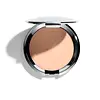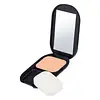What's inside
What's inside
 Key Ingredients
Key Ingredients

 Benefits
Benefits

 Concerns
Concerns

 Ingredients Side-by-side
Ingredients Side-by-side

Talc
AbrasiveAluminum Starch Octenylsuccinate
AbsorbentMica
Cosmetic ColorantMyristyl Trisiloxane
EmollientSilica
AbrasiveEthylhexyl Methoxycinnamate
UV AbsorberLauryl Lactate
EmollientC26-54 Alkyl Tetradecyl Dimethicone
Skin ConditioningDimethicone
EmollientCaprylyl Methicone
Skin ConditioningGlycine Soja Oil
EmollientZinc Stearate
Cosmetic ColorantTrimethylolpropane Triisostearate
EmollientChlorphenesin
AntimicrobialHydrogenated Polydecene
EmollientOctyldodecanol
EmollientPotassium Sorbate
PreservativePolyperfluoroethoxymethoxy Difluoroethyl PEG Phosphate
Skin ConditioningTetrasodium EDTA
Phyllanthus Emblica Extract
Skin ConditioningBHT
AntioxidantTitanium Dioxide
Cosmetic ColorantCI 77491
Cosmetic ColorantCI 77007
Cosmetic ColorantZinc Oxide
Cosmetic ColorantTalc, Aluminum Starch Octenylsuccinate, Mica, Myristyl Trisiloxane, Silica, Ethylhexyl Methoxycinnamate, Lauryl Lactate, C26-54 Alkyl Tetradecyl Dimethicone, Dimethicone, Caprylyl Methicone, Glycine Soja Oil, Zinc Stearate, Trimethylolpropane Triisostearate, Chlorphenesin, Hydrogenated Polydecene, Octyldodecanol, Potassium Sorbate, Polyperfluoroethoxymethoxy Difluoroethyl PEG Phosphate, Tetrasodium EDTA, Phyllanthus Emblica Extract, BHT, Titanium Dioxide, CI 77491, CI 77007, Zinc Oxide
Mica
Cosmetic ColorantTalc
AbrasiveDimethicone
EmollientEthylhexyl Methoxycinnamate
UV AbsorberSilica
AbrasiveTrimethylsiloxysilicate
EmollientNylon-12
Methicone
EmollientCholesteryl Stearate
EmollientTocopherol
AntioxidantBHT
AntioxidantDiethylhexyl Succinate
EmollientEthylhexyl Hydroxystearate
EmollientHydrogen Dimethicone
Methylparaben
PreservativePropylparaben
PreservativeSodium Dehydroacetate
PreservativeCI 77891
Cosmetic ColorantCI 77492
Cosmetic ColorantCI 77491
Cosmetic ColorantCI 77499
Cosmetic ColorantMica, Talc, Dimethicone, Ethylhexyl Methoxycinnamate, Silica, Trimethylsiloxysilicate, Nylon-12, Methicone, Cholesteryl Stearate, Tocopherol, BHT, Diethylhexyl Succinate, Ethylhexyl Hydroxystearate, Hydrogen Dimethicone, Methylparaben, Propylparaben, Sodium Dehydroacetate, CI 77891, CI 77492, CI 77491, CI 77499
Ingredients Explained
These ingredients are found in both products.
Ingredients higher up in an ingredient list are typically present in a larger amount.
BHT is a synthetic antioxidant and preservative.
As an antioxidant, it helps your body fight off free-radicals. Free-radicals are molecules that may damage your skin cells.
As a preservative, it is used to stabilize products and prevent them from degrading. Specifically, BHT prevents degradation from oxidation.
The concerns related to BHT come from oral studies; this ingredient is currently allowed for use by both the FDA and EU.
However, it was recently restricted for use in the UK as of April 2024.
Learn more about BHTCi 77491 is also hydrated iron III oxide. It's sole purpose is to give a red/pink hue to products.
Iron III oxides are classified as inorganic chemicals for coloring.
Synthetically created Ci 77491 is considered safer than those naturally found. This is because the synthetically created version may contain less impurities. Iron oxides are generally non-toxic and non-allergenic.
Learn more about CI 77491Dimethicone is a type of synthetic silicone created from natural materials such as quartz.
What it does:
Dimethicone comes in different viscosities:
Depending on the viscosity, dimethicone has different properties.
Ingredients lists don't always show which type is used, so we recommend reaching out to the brand if you have questions about the viscosity.
This ingredient is unlikely to cause irritation because it does not get absorbed into skin. However, people with silicone allergies should be careful about using this ingredient.
Note: Dimethicone may contribute to pilling. This is because it is not oil or water soluble, so pilling may occur when layered with products. When mixed with heavy oils in a formula, the outcome is also quite greasy.
Learn more about DimethiconeEthylhexyl Methoxycinnamate is an organic compound that provides UVB protection. It often goes by the more common name of octinoxate. It is created from methoxycinnamic acid and 2-ethylhexanol.
Ethylhexyl Methoxycinnamate absorbs UVB rays with wavelengths between 280-320 nm. UV absorbers protect your skin by using chemical reactions to convert UV rays into heat and energy.
UVB (290-320 nm) rays emit more energy than UVA rays. They are capable of damaging DNA, causing sunburns and are thought to be linked to skin cancer.
The state of Hawaii has banned sunscreens containing octinoxate due to its potential impact on coral reefs. More research is needed to bridge gaps in this research. The European Union allows higher levels of octinoxate in sunscreens than the US and Australia.
Ethylhexyl Methoxycinnamate is oil soluble. It is not stable and may lose efficacy when exposed to sunlight.
Learn more about Ethylhexyl MethoxycinnamateMica is a naturally occurring mineral used to add shimmer and color in cosmetics. It can also help improve the texture of a product or give it an opaque, white/silver color.
Serecite is the name for very fine but ragged grains of mica.
This ingredient is often coated with metal oxides like titanium dioxide. Trace amounts of heavy metals may be found in mica, but these metals are not harmful in our personal products.
Mica has been used since prehistoric times throughout the world. Ancient Egyptian, Indian, Greek, Roman, Aztec, and Chinese civilizations have used mica.
Learn more about MicaSilica, also known as silicon dioxide, is a naturally occurring mineral. It is used as a fine, spherical, and porous powder in cosmetics.
Though it has exfoliant properties, the function of silica varies depending on the product.
The unique structure of silica enhances the spreadability and adds smoothness, making it a great texture enhancer.
It is also used as an active carrier, emulsifier, and mattifier due to its ability to absorb excess oil.
In some products, tiny microneedles called spicules are made from silica or hydrolyzed sponge. When you rub them in, they lightly polish away dead skin layers and enhance the penetration of active ingredients.
Learn more about SilicaTalc is a clay mineral. It helps absorb moisture and improve the texture of products. Like other types of clay, Talc can have a slight exfoliating effect on skin. Talc can be added to increase the volume of products.
Some Baby powders are made by combining talc with corn starch. The word "talc" comes from Latin and originates from Arabic. Talc is a mineral commonly found throughout the world.
If you have any concerns about using talc, we recommend checking out the FDA's official page.
Learn more about Talc